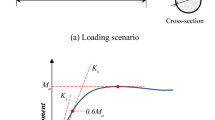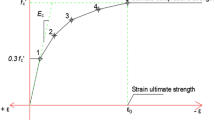Abstract
A one-dimensional Co finite element model (FEM) based on cubic-order beam theory in conjunction with the artificial neural network–genetic algorithm (ANN–GA) and artificial neural network–grey wolf optimization (ANN–GWO) metamodels has been adopted for the bending analysis of the pervious composite beam. The axial displacement field is a third-order equation and a function of the variation of the thickness of the beam. The parabolic variation of the shear stress is assumed; therefore, the shear stress value is zero at the extreme surface of the beam. The validation of the presented model has been done with the published research work and found suitable for further analysis. The Monte Carlo simulation–finite element method (MCS–FEM) has been developed and coded in the FORTRAN environment. The dataset obtained from MCS–FEM is used for the training and testing of the machine learning model. The ANN–GA and ANN–GWO metamodels are coded in the MATLAB environment. The various statistical parameters, regression analysis, and rank analysis have been done to find out the accuracy and efficiency of the proposed soft computation metamodels.












Similar content being viewed by others
References
Pelke, E., Kurrer, K.-E.: On the evolution of steel-concrete composite construction. In: Fifth International Congress on Construction History. pp. 107–116 (2015)
Rohn, A.: Der Neubau der Achereggbrücke über die See-Enge des Vierwaldstättersees bei Stansstad. Rascher & Cie (1915)
Shariati, A.: Various types of shear connectors in composite structures: a review. Int. J. Phys. Sci. (2012). https://doi.org/10.5897/IJPSX11.004
von Emperger, F.E.: Handbuch für Eisenbetonbau. Wilhelm Ernst & Sohn, BERLIN (1912)
Newmark, N.M.: Test and analysis of composite beam with incomplete interaction. Proc. Soc. Exp. Stress Anal. 9, 75–92 (1951)
Zou, Y., Zhou, X.H., Di, J., Qin, F.J.: Partial interaction shear flow forces in simply supported composite steel-concrete beams. Adv. Steel Constr. 14, 634–650 (2018). https://doi.org/10.18057/IJASC.2018.14.7
Satasivam, S., Feng, P., Bai, Y., Caprani, C.: Composite actions within steel-FRP composite beam systems with novel blind bolt shear connections. Eng. Struct. 138, 63–73 (2017). https://doi.org/10.1016/j.engstruct.2017.01.068
Queiroz, F.D., Vellasco, P.C.G.S., Nethercot, D.A.: Finite element modelling of composite beams with full and partial shear connection. J. Constr. Steel Res. 63, 505–521 (2007). https://doi.org/10.1016/j.jcsr.2006.06.003
Girhammar, U.A., Pan, D.: Dynamic analysis of composite members with interlayer slip. Int. J. Solids Struct. 30, 797–823 (1993). https://doi.org/10.1016/0020-7683(93)90041-5
Sun, Q., Zhang, N., Yan, G., Zhu, X., Liu, X., Li, W.: Exact dynamic characteristic analysis of steel-concrete composite continuous beams. Shock Vib. (2021). https://doi.org/10.1155/2021/5577276
Su, H., Banerjee, J.R.: Development of dynamic stiffness method for free vibration of functionally graded Timoshenko beams. Comput. Struct. 147, 107–116 (2015). https://doi.org/10.1016/j.compstruc.2014.10.001
Xu, R., Wu, Y.: Static, dynamic, and buckling analysis of partial interaction composite members using Timoshenko’s beam theory. Int. J. Mech. Sci. 49, 1139–1155 (2007). https://doi.org/10.1016/j.ijmecsci.2007.02.006
Nguyen, Q.H., Martinelli, E., Hjiaj, M.: Derivation of the exact stiffness matrix for a two-layer Timoshenko beam element with partial interaction. Eng. Struct. 33, 298–307 (2011). https://doi.org/10.1016/j.engstruct.2010.10.006
Reddy, J.N.: A simple higher-order theory for laminated composite plates. J. Appl. Mech. Trans. ASME. 51, 745–752 (1984). https://doi.org/10.1115/1.3167719
Taj, M.G., Chakrabarti, A., Talha, M.: Bending analysis of functionally graded skew sandwich plates with through-the thickness displacement variations. J. Sandwich Struct. Mater. 16, 210 (2014)
Lezgy-Nazargah, M., Kafi, L.: Analysis of composite steel-concrete beams using a refined high-order beam theory. Steel Compos. Struct. 18, 1353–1368 (2015). https://doi.org/10.12989/scs.2015.18.6.1353
Chakrabarti, A., Sheikh, A.H., Griffith, M., Oehlers, D.J.: Analysis of composite beams with partial shear interactions using a higher order beam theory. Eng. Struct. 36, 283–291 (2012). https://doi.org/10.1016/j.engstruct.2011.12.019
Lawson, M., Wickens, P.: Composite beams. Steel Des. Man. Steel Constr. Instit. 8, 601–650 (2008). https://doi.org/10.1002/9780470775097.ch21
Heshmati, M., Daneshmand, F.: Vibration analysis of non-uniform porous beams with functionally graded porosity distribution. Proc. Inst. Mech Eng. Part L J. Mater. Des. Appl. 233, 1678–1697 (2019). https://doi.org/10.1177/1464420718780902
Wu, D., Liu, A., Huang, Y., Huang, Y., Pi, Y., Gao, W.: Dynamic analysis of functionally graded porous structures through finite element analysis. Eng. Struct. 165, 287–301 (2018). https://doi.org/10.1016/j.engstruct.2018.03.023
Pradeep, T., GuhaRay, A., Bardhan, A., Samui, P., Kumar, S., Armaghani, D.J.: Reliability and prediction of embedment depth of sheet pile walls using hybrid ANN with optimization techniques. Arab. J. Sci. Eng. 47, 12853–12871 (2022). https://doi.org/10.1007/s13369-022-06607-w
Wang, Q., Li, Q., Wu, D., Yu, Y., Tin-loi, F., Ma, J.: Machine learning aided static structural reliability analysis for functionally graded frame structures. Appl. Math. Model. 78, 792–815 (2020). https://doi.org/10.1016/j.apm.2019.10.007
Thanh, H., Hieu, D., Phan, C.: Assessment of critical buckling load of functionally graded plates using artificial neural network modeling. Neural Comput. Appl. 33, 16425–16437 (2021). https://doi.org/10.1007/s00521-021-06238-6
Do, D.T.T., Lee, D., Lee, J.: Material optimization of functionally graded plates using deep neural network and modified symbiotic organisms search for eigenvalue problems. Compos. Part B 159, 300–326 (2019). https://doi.org/10.1016/j.compositesb.2018.09.087
Karamov, R., Akhatov, I., Sergeichev, I.V.: Prediction of fracture toughness of pultruded composites based on supervised machine learning. Polymers 14, 3619 (2022)
Xu, W., Fu, Z.: Thermal conductivity identification in functionally graded materials via a machine learning strategy based on singular boundary method. Mathematics 10, 458 (2022)
Zazoum, B., Triki, E., Bachri, A.: Modeling of mechanical properties of clay-reinforced polymer nanocomposites using deep neural network. Materials 13, 1996–1944 (2020). https://doi.org/10.3390/ma13194266
Chakravarty, S., Garg, P., Kumar, A., Agrawal, M., Prabhat, K.: Deep neural networks based predictive-generative framework for designing composite materials. Sci. Eng. 30, 1–27 (2022)
Wang, Q., Wu, D., Tin-loi, F., Gao, W.: Thin-walled structures machine learning aided stochastic structural free vibration analysis for functionally graded bar-type structures. Thin-Wall. Struct. 144, 8 (2019). https://doi.org/10.1016/j.tws.2019.106315
Gu, G.X., Chen, C., Buehler, M.J.: De novo composite design based on machine learning algorithm. Extreme Mech. Lett. 18, 19–28 (2018). https://doi.org/10.1016/j.eml.2017.10.001
Ding, X., Hou, X., **a, M., Ismail, Y., Ye, J.: Predictions of macroscopic mechanical properties and microscopic cracks of unidirectional fibre-reinforced polymer composites using deep neural network (DNN). Compos. Struct. 302, 116248 (2022). https://doi.org/10.1016/j.compstruct.2022.116248
Bülbül, M.A., Harirchian, E., Işık, M.F., Aghakouchaki Hosseini, S.E., Işık, E.: A Hybrid ANN-GA model for an automated rapid vulnerability assessment of existing RC buildings. Appl. Sci. (2022). https://doi.org/10.3390/app12105138
Chandwani, V., Agrawal, V., Nagar, R.: Modeling slump of ready mix concrete using genetic algorithms assisted training of artificial neural networks. Expert Syst. Appl. 42, 885–893 (2015). https://doi.org/10.1016/j.eswa.2014.08.048
Wu, N.J.: Predicting the compressive strength of concrete using an RBF-ann model. Appl. Sci. (2021). https://doi.org/10.3390/app11146382
Ferreira, F.P.V., Shamass, R., Limbachiya, V., Tsavdaridis, K.D., Martins, C.H.: Lateral–torsional buckling resistance prediction model for steel cellular beams generated by Artificial Neural Networks (ANN). Thin-Wall Struct. 170, 108592 (2022). https://doi.org/10.1016/j.tws.2021.108592
Jeyasehar, C.A., Sumangala, K.: Damage assessment of prestressed concrete beams using artificial neural network (ANN) approach. Comput. Struct. 84, 1709–1718 (2006). https://doi.org/10.1016/j.compstruc.2006.03.005
Kilicarslan, S., Celik, M., Sahin, Ş: Hybrid models based on genetic algorithm and deep learning algorithms for nutritional Anemia disease classification. Biomed. Signal Process. Control. (2021). https://doi.org/10.1016/j.bspc.2020.102231
Kociecki, M., Adeli, H.: Two-phase genetic algorithm for topology optimization of free-form steel space-frame roof structures with complex curvatures. Eng. Appl. Artif. Intell. 32, 218–227 (2014). https://doi.org/10.1016/j.engappai.2014.01.010
Mirjalili, S., Mirjalili, S.M., Lewis, A.: Grey wolf optimizer. Adv. Eng. Softw. 69, 46–61 (2014). https://doi.org/10.1016/j.advengsoft.2013.12.007
Joshi, H., Arora, S.: Enhanced grey wolf optimization algorithm for global optimization. Fundam. Informaticae. 153, 235–264 (2017). https://doi.org/10.3233/FI-2017-1539
Andalib, A., Aminnejad, B., Lork, A.: Grey wolf optimizer-based ANNs to predict the compressive strength of self-compacting concrete. Appl. Comput. Intell. Soft Comput. (2022). https://doi.org/10.1155/2022/9887803
Cinar, A.C., Natarajan, N.: An artificial neural network optimized by grey wolf optimizer for prediction of hourly wind speed in Tamil Nadu. India. Intell. Syst. with Appl. 16, 200138 (2022). https://doi.org/10.1016/j.iswa.2022.200138
Muro, C., Escobedo, R., Spector, L., Cop**er, R.P.: Wolf-pack (Canis lupus) hunting strategies emerge from simple rules in computational simulations. Behav. Process. 88, 192–197 (2011). https://doi.org/10.1016/j.beproc.2011.09.006
Shen, X., Chen, W., Wu, Y., Xu, R.: Dynamic analysis of partial-interaction composite beams. Compos. Sci. Technol. 71, 1286–1294 (2011). https://doi.org/10.1016/j.compscitech.2011.04.013
Acknowledgements
It is my pleasure to acknowledge and thank my supervisor for his technical guidance and assistance.
Author information
Authors and Affiliations
Corresponding author
Ethics declarations
Conflict of interest
On behalf of all authors, the corresponding author states that there is no conflict of interest.
Ethical approval
This article does not contain any studies with human participants or animals performed by any of the authors.
Additional information
Publisher's Note
Springer Nature remains neutral with regard to jurisdictional claims in published maps and institutional affiliations.
Appendix
Appendix
Statistical parameters:
Rights and permissions
Springer Nature or its licensor (e.g. a society or other partner) holds exclusive rights to this article under a publishing agreement with the author(s) or other rightsholder(s); author self-archiving of the accepted manuscript version of this article is solely governed by the terms of such publishing agreement and applicable law.
About this article
Cite this article
Kumar, P., Kumar, A., Kumar, S. et al. Bending behaviour of steel–concrete composite beam with partial shear interface using MCS and ANN. Acta Mech 235, 4451–4471 (2024). https://doi.org/10.1007/s00707-024-03949-4
Received:
Revised:
Accepted:
Published:
Issue Date:
DOI: https://doi.org/10.1007/s00707-024-03949-4




